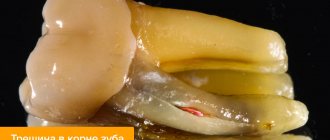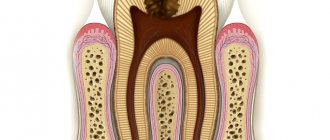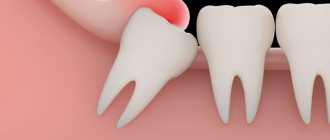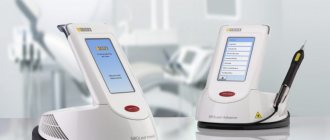Causes of a crack in the root of a tooth
Not all patients understand why a root crack occurs in a living tooth. The reason lies in the uneven distribution of the load. Moreover, the load can be strong and sudden, or it can accumulate over years and lead to the appearance of a crack after some time.
Typically, the cause of a crack is caused by the following factors:
- domestic trauma
- blow, fall, sudden load while chewing; - improper treatment
- strong pressure when cleaning canals or filling the root can injure the walls and in the future, with the slightest excessive load, cause a crack in the root; - error during prosthetics
- strong pressure when installing a pin or the manufacture of inappropriate dentures that unevenly distribute the load during chewing, leading to injury; - Bruxism
- unconscious clenching of the jaws, for example, during sleep, leads to a load that the patient does not notice and cannot control.
Diagnosis and treatment
During the diagnosis, the specialist:
- evaluates patient complaints,
- examines the oral cavity,
- performs testing with coloring reagents,
- examines the x-ray.
After assessing the size of the crack and the depth of tissue damage, the dentist draws up a treatment plan. It may include:
- remineralization and fluoridation of enamel,
- tooth restoration,
- installation of a crown on a pin,
- removal of a damaged tooth followed by implantation.
The choice of treatment method depends on the nature of the tooth damage, the condition of the root, and existing contraindications. Dentists try to preserve their patients' teeth.
Types of tooth root crack
Pressure can be applied both vertically and perpendicularly to the crown. The following types of cracks are distinguished:
- oblique crack of a tooth
- a diagonal fracture, usually the healthy part is much larger, and the doctor can save the tooth by removing the affected part; - transverse crack of a tooth
- part of the root is completely broken off and deprived of nutrition; the closer the crack is to the coronal part, the higher the risk of complications; - longitudinal crack in the root of a tooth
- the fracture runs vertically, along the axis of the root, often accompanied by a fracture of the crown; - comminuted tooth crack
- multiple root fractures intersecting with each other.
Root crack diagnosis
Only a doctor can diagnose an injury. First, the specialist makes a preliminary diagnosis based on the patient’s symptoms and complaints. More detailed research is required to clarify.
- Instrumental examination.
By tapping the tooth, the doctor determines whether there are irregularities, fractures or bleeding in the root of the tooth. - X-ray.
The image clearly shows the tooth root crack, its location and the severity of the injury. - Electrical exposure
helps determine the condition of the pulp.
Symptoms of deep cracks
Deep cracks can be detected with the naked eye, especially if the front teeth are cracked. Shallow clefts are more difficult to self-diagnose. Therefore, it is important to pay attention to the symptoms of a cracked tooth.
First of all, this is increased sensitivity of the enamel on the teeth. Increased discomfort occurs when eating cold or hot food.
As the crack grows and the root of the tooth is damaged, the symptoms intensify - the cracked tooth begins to hurt. The syndrome is worsened by eating solid foods and brushing.
With a vertical hole, a long absence of dental intervention leads to the development of catarrhal processes in the soft tissues of the tooth. Lack of treatment for a cracked tooth provokes damage to the root and nerve of the tooth, which is accompanied by severe pain, hyperthermia, swelling and redness of the gums.
Necrotic processes of a cracked tooth root are accompanied by symptoms such as discoloration of the enamel, swelling of the gums, pain at the site of the pathological process, and loosening of the tooth.
Crack in the root of a tooth: what to do
After diagnosis, patients are concerned with the question of whether it is possible to cure a crack in the root of a tooth. It all depends on the severity of the injury, the type of fracture and location. But there is no therapeutic treatment - tablets, ointments and injections; in any case, surgical intervention is necessary.
Ⅰ.
In case of a transverse fracture, the tooth can be saved, but the pulp is removed without exception. The doctor cleans and fills the root canals, and fastens the crack with a pin. Now the tooth needs rest and a minimum of chewing load - to reduce mobility, the teeth are splinted, that is, fixed in the correct position with a special splint-onlay.
Ⅱ.
Splintered, vertical and oblique cracks in most cases are only the initial stage of destruction of the root system, and over time the fault will grow. Therefore, depending on the severity of the injury, the doctor removes either part of the root with a crown or the entire tooth. A partially lost tooth can be restored using an inlay on a pin, or a complete tooth can be restored by installing a prosthesis or implant.
Treatment of a crack in the root of a tooth requires following the following recommendations:
- limit the chewing load - it is better to eat soups, cereals and other soft foods, avoid hard foods;
- monitor the temperature - all foods and drinks should be slightly warm, ice cream or hot tea have an undesirable effect on the injured root;
- eliminate pressure - do not open your mouth wide, do not close your jaw too tightly, brush your teeth carefully, avoid blows.
Chips are different
Dental chips are deep injuries that expose the nerve. Such injuries usually cause severe pain and increased sensitivity. It even happens that the tooth bleeds. In this case, it is necessary to treat the root canal and, most likely, remove the nerve. Next, the tooth is filled (if possible) or a crown is placed.
Deep vertical cracks originate at the base of the tooth and rise up to the chewing surface, causing acute pain. It is likely that the area around the root will become inflamed if it becomes infected. Such a tooth will most likely need to be removed, but the final decision is made by the dentist after an examination.
If the tooth has deteriorated due to internal voids, then you will need to take an X-ray to assess the scale of the “catastrophe.”
Typically, specialists determine the size and nature of the cavity, and then make recommendations for restoring the tooth. It happens that a tooth has to be removed because the void continues to grow towards the bone. Moscow metro station Zvezdnaya, Danube Avenue, 23
Complications and consequences of a root crack
In this situation, timely treatment is important: seeing a doctor at the initial stage will help avoid consequences. If this is not done, you may encounter the following complications:
- abscess.
A crack without treatment can provoke an inflammatory process, which in the future will turn into suppuration of soft tissues and lead to the formation of an abscess. Treatment of a purulent cavity is much longer, more expensive and unpleasant than treatment of a fissure; - phlegmon.
Suppuration, which, unlike an abscess, does not have clear boundaries and does not flow into the formation of a cavity. Cellulitis is a decay of cells that can spread to any tissue in the cavity; - periodontitis.
Inflammation of the periodontium, that is, the tissues surrounding the tooth, leads to their death and the inability to hold the tooth in the gum. The result is the complete loss of one or more teeth; pulpitis. The death of the pulp - the neurovascular bundle of tissues in the tooth through which it receives nutrition. Pulpitis is quite painful and can affect neighboring tissues; - tissue injury.
A root fragment can injure soft tissue. In this case, the doctor will have to extract a piece of the root and remove the infected tissue.
How to treat a cracked tooth?
There are several ways to restore the integrity of a tooth. The choice is made by the dentist based on the results of the study.
What to do if the enamel is cracked?
If only the tooth enamel is cracked, the dentist offers 2 procedures:
- reminilization with saturation of the enamel with a mineral composition, which helps prevent further tooth splitting;
- fluoridation – strengthening is carried out with fluorine-containing preparations in several stages.
Sealing
This method is most often used when a chewing tooth is cracked in half. This method allows you to mask minor clefts while maintaining the shade of the enamel. Before installing the filling, the root canal is cleaned.
Veneers and Lumineers
Veneers and lumineers are porcelain or composite plates that replace the top layer of the tooth. They are installed when a tooth has cracked horizontally or diagonally, and the chip is not deep or does not have branches to the root of the tooth. This method allows you to restore the tooth, but also restore the aesthetic appearance of your smile.
Building up
Extension is a painless procedure that is performed using composite resin. The color is selected based on the natural shade of the enamel.
Bonding a cracked tooth with composite resins does not require special preparation, and the procedure is painless and lasts no more than an hour.
To preserve the extended tooth, dentists at the Partner-Med clinic recommend avoiding biting hard foods, eating foods with dyes, and minimizing the risk of mechanical and thermal injuries.
Prosthetics
If a tooth is cracked at the root, root treatment may be required. After root treatment, if necessary, a pin is installed, with which the crown is placed on the cracked tooth. It is also possible to install a bridge prosthesis with grinding of adjacent units.
Removal
Removal of a cracked tooth is carried out in the following cases:
- it is impossible to restore the integrity of tissues using prosthetics or filling;
- the root and tissue of the tooth are damaged by bacterial processes;
- The tooth is cracked and loose, indicating root damage.
Specialists at the Partner-Med clinic will help restore the integrity of teeth with cracks of varying depths and degrees of complexity, as well as restore the attractiveness of your smile. Dentists also recommend minimizing traumatic factors that can lead to damage to the teeth and materials used to restore the tooth.
Request a call back or dial our number!
+7
This phone call does not obligate you to anything. Just give us a chance and we will help you!
- Inexpensive dentistry in Moscow
- Cofferdam
- Sea buckthorn
- Implantation of molars
- Veneers or Lumineers – which is better?
- Bleeding gums
- Comfrey officinalis
- Reviews of dental services
- Guided bone regeneration
- Xerostomia
- Paracetamol
- Veneers for crooked teeth
- Reviews of dental services
- Pentalgin
- Curettage
- In-canal teeth whitening
- Reviews of dental services
- Laser dental implantation
Just pick up the phone and call us!
+7
We will definitely make you an offer that you cannot refuse!
Prevention of root injuries
The best treatment is disease prevention. To prevent cracks at the root, try to follow a few recommendations:
- be careful and attentive, because half of the cases of root cracks are household injuries, which can be avoided if you take care of yourself and your health;
- carefully choose a clinic and a doctor - before visiting a dentist, check the reviews and ratings of the clinic, certificates and specialist diplomas, do not go to questionable dentists;
- strengthen your teeth - eat healthy foods, do not forget about the importance of calcium and fluoride in strengthening your teeth, choose suitable dental hygiene products.
If symptoms of a root crack occur, do not self-medicate and do not wait for the pain to go away on its own. See your doctor. If the pain is caused by a temporary phenomenon, you will be calm, and if a crack is discovered at the root, treatment at the initial stage will help maintain the health and beauty of your smile, avoid complications and unnecessary expenses.
Why do cracks appear in enamel?
There are several reasons why chips and cracks appear. The most common of them:
- Mechanical
. The habit of chewing pens and pencils, husking seeds, and opening bottles with teeth lead to microtraumas that grow into large ones. - Chemical
. Sour and sweet foods, carbonated drinks, and frequent whitening destroy tooth enamel. - Temperature
. Hot food washed down with ice-cold drinks is a direct path to enamel cracks. - Physical
. It is better to use abrasive toothpastes periodically, and then give the enamel a chance to “rest.” - Traumatic
. This can be a one-time injury, for example, falling from a bicycle, or regular microtrauma, as during sports. - Age
. With age, teeth become more fragile and restoration mechanisms slow down.
Do you have small cracks on your teeth? This already indicates that you need to reconsider your habits, make changes to your diet and be sure to visit the dentist.










